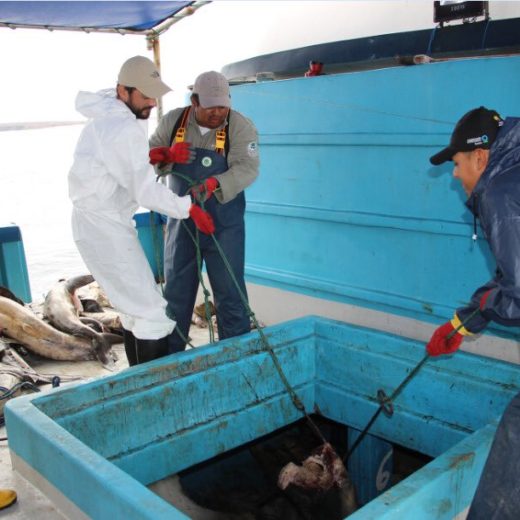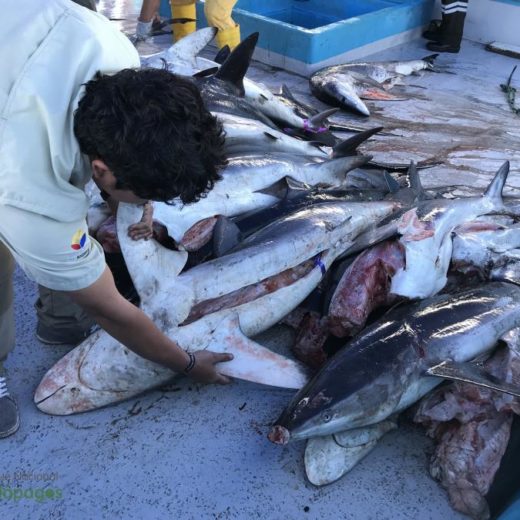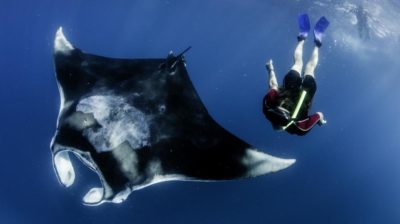
TEXT & PHOTOS COURTESY OF SHAWN HEINRICHS/RACING EXTINCTION
Of the handful of locations that account for the majority of manta fishers, the central Indonesian village of Lamakera is at the top and is considered the world’s largest manta fishing site. Villagers here have conducted traditional manta hunts for many generations, but with the arrival of the gill plate trade in the early 2000s, the community converted to diesel engines and transformed to a full-scale commercial fishery, landing over 1,000 mantas in a single season.
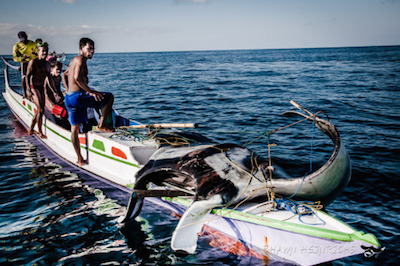

Since then, the fishing intensity has only increased, sending the manta population into a downward spiral. Having documented this grisly hunt, we wondered how could we possibly mobilize action to save this vanishing species before it was too late? We had to act but needed international and domestic support first to make it happen.
Manta Sanctuary
Following a landmark victory for mantas at the 2013 Convention on International Trade in Endangered Species of Wild Fauna and Flora (CITES), and after a one-year campaign in Indonesia by Conservation International and WildAid, in January of 2014 we achieved an unprecedented achievement: securing full national protection for manta rays and establishing Indonesia as the world’s largest manta sanctuary.
With this landmark legislation in place, we immediately turned our attention back to Lamakera and began planning in earnest what would become the kick-off for a massive community transition program to end the slaughter of manta rays.
Lamakera Ocean Theater
Our team traveled by air to Bali and onward to Flores, then by trucks over the rugged mountains of Flores, and finally by sea to the village of Lamakera. Undeterred by scorching sun followed by monsoon downpours, together with the community we erected the massive screen and inflated our giant 21-foot inflatable manta ray. As the sun dropped below the horizon we switched the projector on, and what followed was one of the most powerful and transformative moments for not only for this community, but also for the Racing Extinction team.
Lamakerans gathered by the hundreds in the schoolyard, while more lined the fences surrounding the yard. When the first images of a giant manta lit up the screen, a hush fell over the stunned crowd, followed immediately by deafening cheers of exuberant children. The show was on! We delighted them with profound imagery, video shorts featuring stunning blue chip marine footage, and conservation stories about manta rays and the oceans. Even the most hardened of the manta hunters were transfixed by beauty of a world they had only witnessed from the other end of a harpoon shaft.
Turning our gaze to the screen, we noticed a row of small children sitting, their beautiful dark wide eyes soaking up every image on the screen. For these children a seed was planted and a brilliant transformation was already taking place. Suddenly their futures presented exciting new opportunities, not as hunters, but as guides, researchers and maybe even photographers. We felt hope return, and I saw a path to end the slaughter and transform the livelihoods of this remote community.
A New Day in Lamakera
Building off this spirit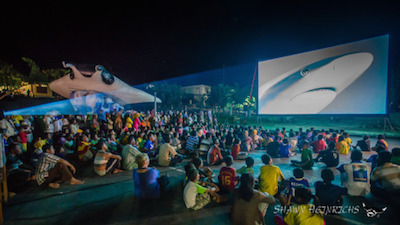

However, a community transition to new industries can be extremely challenging, especially in a place like Lamakera, where the manta hunt is not just a source of income for locals but also a source of pride and traditional identity. As such, we are engaging respectfully and carefully to ensure that our presence is invited and respected throughout the communities. Our activities in the villages are completely transparent, and designed to engage every interested or concerned villager in public forum. The decision to stop fishing may come from the village elders, but the vast majority of people must support the transition for it to be effective. 

A successful initiative that ends the manta hunts will not only play a pivotal role in helping Lamakera find a sustainable path forward, but will also create an inspiring example to the rest of Indonesia, and the world, that we can effectively conserve vulnerable marine life, even in some of the most challenging sites on earth.
How You Can Help
You can support this project by contributing at www.wildaid.org/lamakera.
Stay in touch and get the latest WildAid updates.
SIGN UPAbout WildAid
WildAid is a non-profit organization with a mission to protect wildlife from illegal trade and other imminent threats. While most wildlife conservation groups focus on protecting animals from poaching, WildAid primarily works to reduce global consumption of wildlife products such as elephant ivory, rhino horn and shark fin soup. With an unrivaled portfolio of celebrity ambassadors and a global network of media partners, WildAid leverages more than $308 million in annual pro-bono media support with a simple message: When the Buying Stops, the Killing Can Too.
Journalists on deadline may email communications@wildaid.org
